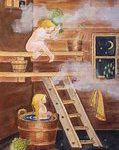Last Updated on 12 months by Francis
Negative ions have been found to have the potential to clean the air, but their effectiveness is still a topic of debate. They are thought to work by attaching to pollutants and allergens, causing them to become too heavy to remain in the air and fall to the ground. In this discussion, we will take a closer look at the science of negative ions, and whether or not they can truly improve air quality.
Contents
Understanding Negative Ions
When it comes to improving the air quality in our homes, negative ions are often mentioned as a solution. But what exactly are negative ions and how do they work? Negative ions are molecules that are formed when an atom gains an electron. They are abundant in nature, especially in areas with flowing water such as waterfalls, oceans, and rivers. Negative ions are also produced by lightning and UV radiation from the sun.
How Do Negative Ions Clean the Air?
Negative ions are believed to have the ability to clean the air by attaching themselves to positively charged particles such as dust, pollen, and mold spores. Once attached, the particle becomes too heavy to remain suspended in the air and falls to the ground. This process is known as air ionization.
The Benefits of Negative Ions
Negative ions have been touted as having many benefits, including improving mood, reducing stress, and increasing energy levels. Some studies have even suggested that negative ions may have a positive effect on respiratory function and may provide relief for people with allergies and asthma.
The Science Behind Negative Ions
While there is some evidence to support the benefits of negative ions, the science behind their effectiveness is not entirely clear. Some researchers have pointed out that the concentration of negative ions needed to have a significant effect on air quality is much higher than what is typically found in indoor environments.
The Importance of Airflow
Airflow is also an important factor to consider when it comes to air quality. Simply adding negative ions to a stagnant room may not be enough to improve the air quality. Proper ventilation and airflow are crucial for ensuring that pollutants are removed from the air.
The Impact of Positive Ions
Another factor to consider is the impact of positive ions on air quality. Positive ions are produced by electronic devices such as televisions, computers, and air conditioners. They may contribute to poor air quality by attracting dust and other pollutants.
Using Negative Ions to Improve Air Quality
While the science behind negative ions is not entirely clear, there are steps that can be taken to use them to improve air quality in the home.
Natural Sources of Negative Ions
One of the easiest ways to increase the concentration of negative ions in the air is to bring natural sources into the home. Plants are a great way to do this as they produce negative ions as part of the photosynthesis process. Salt lamps are another popular option as they release negative ions when heated.
Air Purifiers
Another option is to use an air purifier that uses negative ion technology. These devices use an electric charge to produce negative ions that attach to pollutants in the air, neutralizing them and making them too heavy to remain airborne.
Combining Methods
Combining natural sources of negative ions with an air purifier can be an effective way to improve air quality in the home. Additionally, taking steps to improve ventilation and airflow can further enhance the effectiveness of these methods.
Negative Ions and Air Quality
While the science behind negative ions and their ability to clean the air is not entirely clear, there is evidence to suggest that they can have a positive impact on air quality. By combining natural sources of negative ions with air purifiers and improving ventilation, it is possible to create a cleaner and healthier indoor environment.
FAQs – Can Negative Ions Clean the Air?
What are negative ions?
Negative ions are molecules that have one or more electrons attached, giving them a negative electrical charge. They are found in natural environments such as mountains, waterfalls, and forests and can also be produced artificially by electronics devices such as air purifiers and ionizers.
Negative ions work by binding to airborne particles, such as dust, pollen, and pet dander, causing them to become too heavy to remain suspended in the air. These particles then fall to the ground, effectively removing them from the air. As a result, the air becomes cleaner and fresher.
Is there any scientific evidence to support the effectiveness of negative ions in cleaning the air?
While there is some scientific evidence to suggest that negative ions can improve air quality, there is not enough research available to fully support these claims. Some studies have shown that negative ions can decrease airborne allergens and bacteria, while others have suggested that they do not have a significant effect.
Are there any potential health risks associated with negative ions?
In general, negative ions are safe and do not pose any significant health risks. However, some people may experience negative side effects such as headaches, nausea, and dizziness when exposed to high levels of negative ions. It is important to always follow the manufacturer’s instructions when using ionizing products.
Can negative ions replace air purifiers?
Negative ions do have the potential to improve air quality, but they cannot replace traditional air purifiers completely. Air purifiers use a combination of technologies, such as mechanical filters and ultraviolet light, to remove pollutants from the air. While negative ions can help to reduce airborne particulate matter, they are not effective in removing gaseous pollutants such as volatile organic compounds (VOCs).

.jpg)





